Israel-Iran 12-Day War in the Middle East, ex-post evaluation
Western mainstream media (MSM) declared Israel and the US the winners in this war. This article aims to provide a versatile and cool study of the achievements and losses of some parties. Wide range of various data sources have been used, but as usual, most of them have been based on estimates and assessments by experts, not exact, confirmed facts by the parties of the conflict.
My previous article, “WW3 in the making in the Middle East?” June 24,dealt with the events and processes during the 12 days war, and here I will focus on the aftermath of this war.
The parties here, under study, are on the other hand: the US and Israel, and on the other hand: Iran and its allies China, Russia and North Korea.
Europe & the EU have, once again, proved to be vassals playing only minor side roles. Internationally, nobody is interested in their empty promises or woke opinions any more.
What happened
In the early morning hours of June 13, Israel launched a military operation, “Rising Lion”, against Iran. Less than 24 hours later, Iran retaliated. Nine days later, on the morning of June 22, US jets attacked three Iranian nuclear facilities, entering the conflict. The following evening, Tehran launched a missile strike on Al Udeid, the largest US military airbase in the region, located in Qatar. According to the US authorities, there were no casualties or significant damage.
On June 24, Trump announced that Israel and Iran had agreed to a complete ceasefire and underlined the key winning role of the US in this process. The Israeli authorities confirmed that they had accepted the US proposal and announced that they had completed all objectives in their operation against Iran. In turn, Tehran said that it had achieved a victory over Tel Aviv by forcing it to unilaterally halt its aggression. Thus, each acting party declared a victory.

IDF’s Farsi (Persian) graphic says “The Lion of Judah is Victorious” but was it?
Assessment of achievements / losses
My assessment below is based on versatile data sources, which represent a wide range of different views regarding the dénouement of the war. But as said above, most of them have been based on estimates and assessments by experts, not exact, confirmed facts by the parties of the conflict.
In the article “Who Won The 12-Day War?”, on the website of ZeroHedge, there are interesting data (but mainly along MSM narrative). Here below the key takeaways of this assessment:
- the ratio of Israel-Iran “sufferings” was 1:25, Iran suffered large strategic damages and key personnel losses
- Israel’s air defense intercepted most of the Iranian missiles
- political winners were President Trump, Israel and the Sunni Gulf States
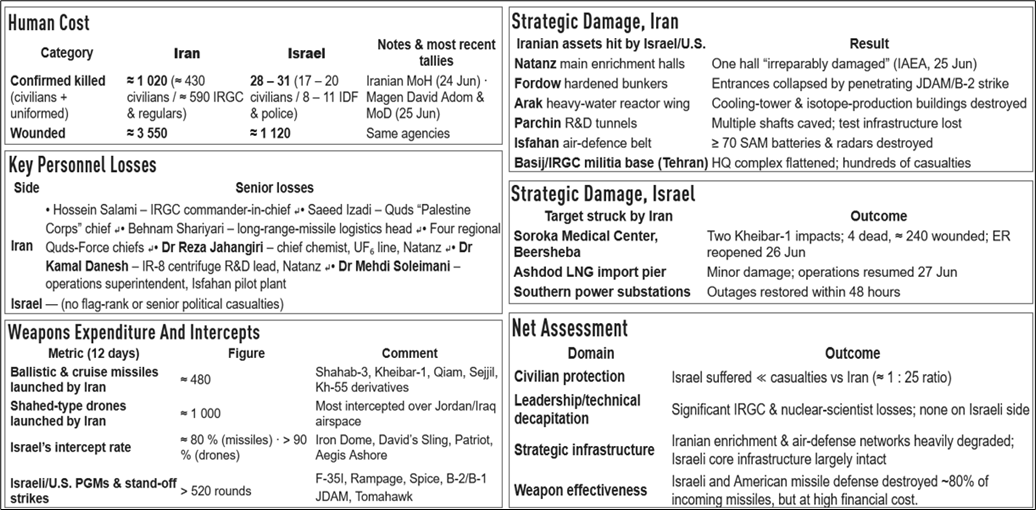
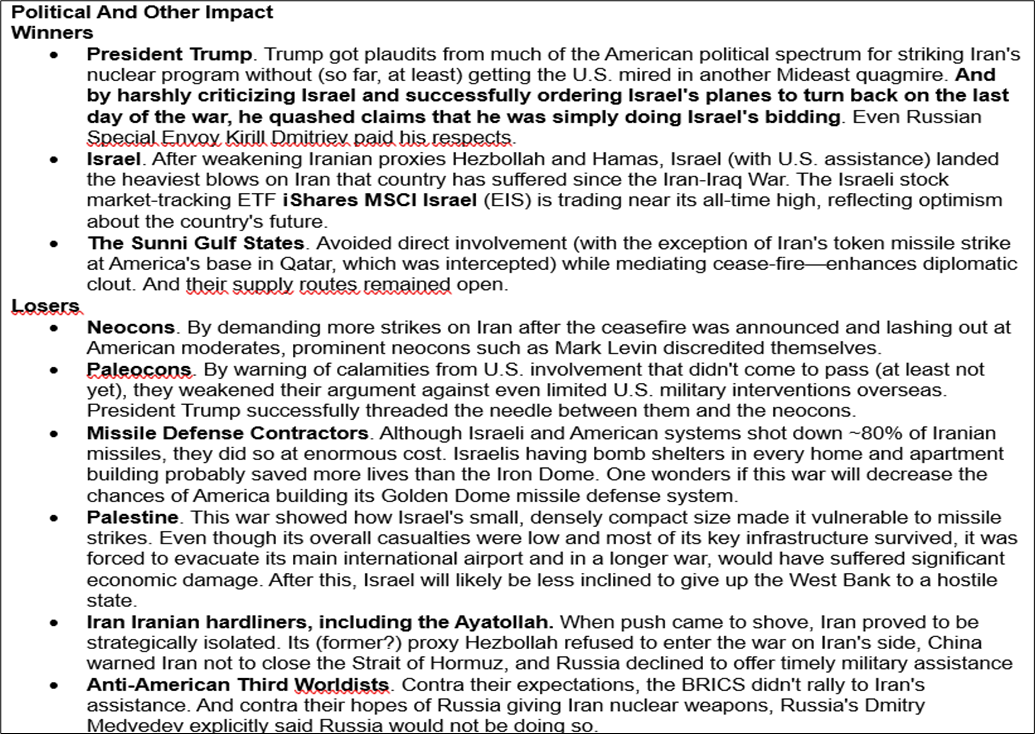
However, many prominent, internationally well-known experts and military analysts share quite different and certainly more versatile view of the results.
Strategic damages in Iran and Israel
Iran’s nuclear centers were not destroyed or severely damaged, only on the surface, and nuclear material(60%-enriched, over 400kg uranium was moved to a secret place). As stated above, some key military and scientific personnel were killed, significant number of air defense systems were destroyed as well as missile launch sites but no aircraft.
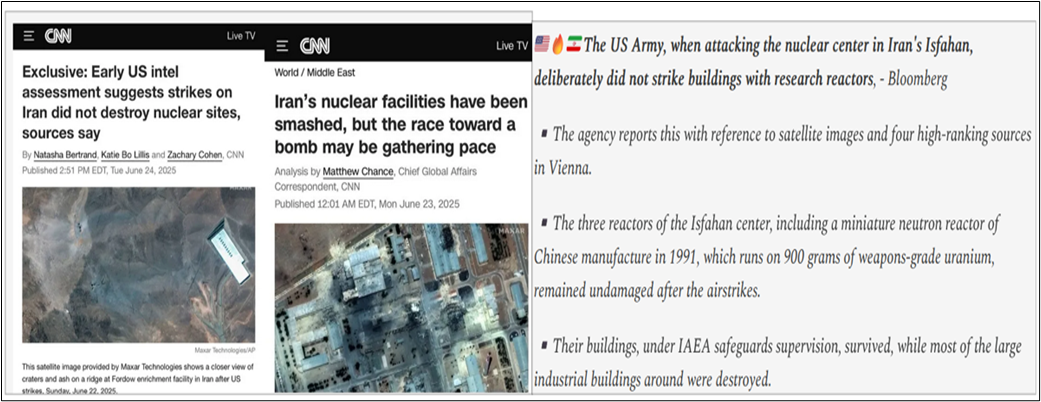
Strategic damages in the Israeli infrastructure were massively larger than preliminary presented.
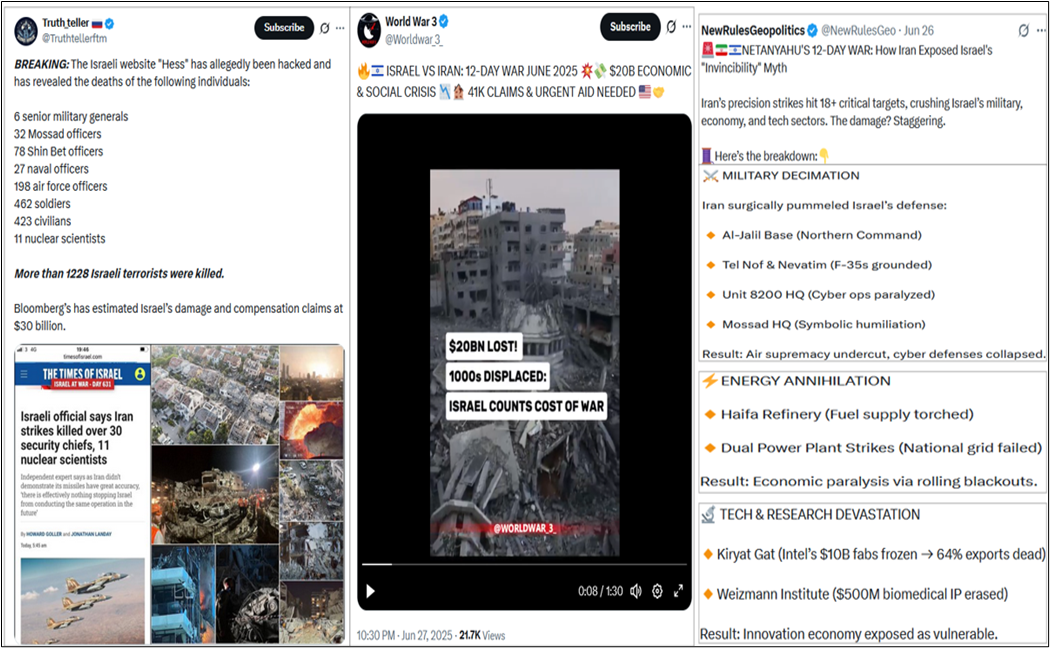
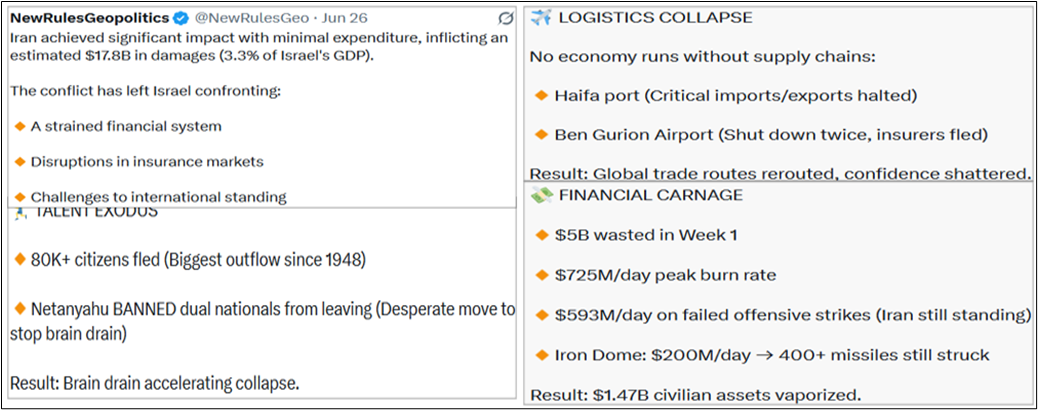
Not only Israeli strategic infrastructure was damaged but also different military installations and even numerous aircraft.
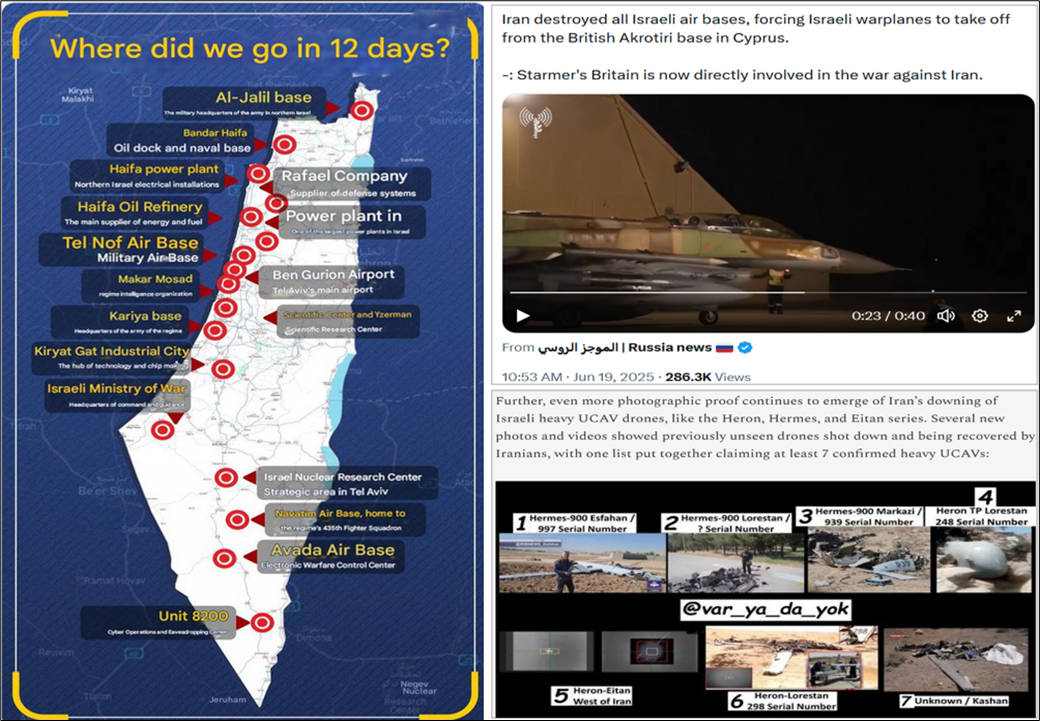
Initial success in the Israeli campaign
Perhaps the most successful part of Israeli military operation was the cyber attack to suppress the air defense before the actual aircraft attacks. Israel’s strikes intended to impose discrete military effects on Iran that made it difficult for Iran to respond quickly. The strikes have targeted air defenses and missile sites as well as key leaders. These strikes appear to be imposing three effects on the Iranian military:
- Suppressing Iranian air defenses. Israel has struck some key components of Iranian air defense systems, including an early-warning radar at the Khatam al Anbia in Hamadan Province. Strikes that destroy components of Iran’s air defense systems will cause a temporary disruption to Iranian defenses that would enable Israeli 4th-generation, non-stealthy aircraft to operate in Iranian airspace with greater ease.
- Degrading Iranian retaliatory capabilities. Israeli airstrikes and drones have struck numerous Iranian ballistic missile silos and launchers. These strikes may have destroyed some of Iran’s missiles, launchers, and missile stockpiles, which would limit Iran’s ability to immediately retaliate in a meaningful way. Iran claimed on June 11 that it had finalized plans for an “immediate counterstrike” against Israel that would involve hundreds of ballistic missiles, but may have only been able to enact part of its plan due to degraded capabilities. A large-scale Iranian missile attack, launched about 10 hours later, targeting Israel, may suggest that the degradation of Iran’s retaliatory capability had only a limited temporal effect.
- Disrupting Iranian command-and-control. Israel has conducted a decapitation campaign targeting Iranian military leadership. This disruption is temporary and limited, however. Supreme Leader Ali Khamenei has already appointed successors for a majority of the military leadership that killed. Iran has presumably already drafted a plan for retaliation that these successors can adopt. The successors may have difficulty implementing the retaliation plan, however, given the losses incurred from Israeli strikes targeting Iran’s retaliatory capabilities.
These constraints have contributed to Israel’s immediate success and set conditions for Israel to continue and expand the campaign as needed. Israeli strikes on nuclear facilities serve Israel’s long-term purpose of removing the Iranian nuclear threat and protecting Israel.
However, Israel’s initial success was quite short-lived and the strikes from both sides during next days disclosed the vulnerability of both side’s air defenses.
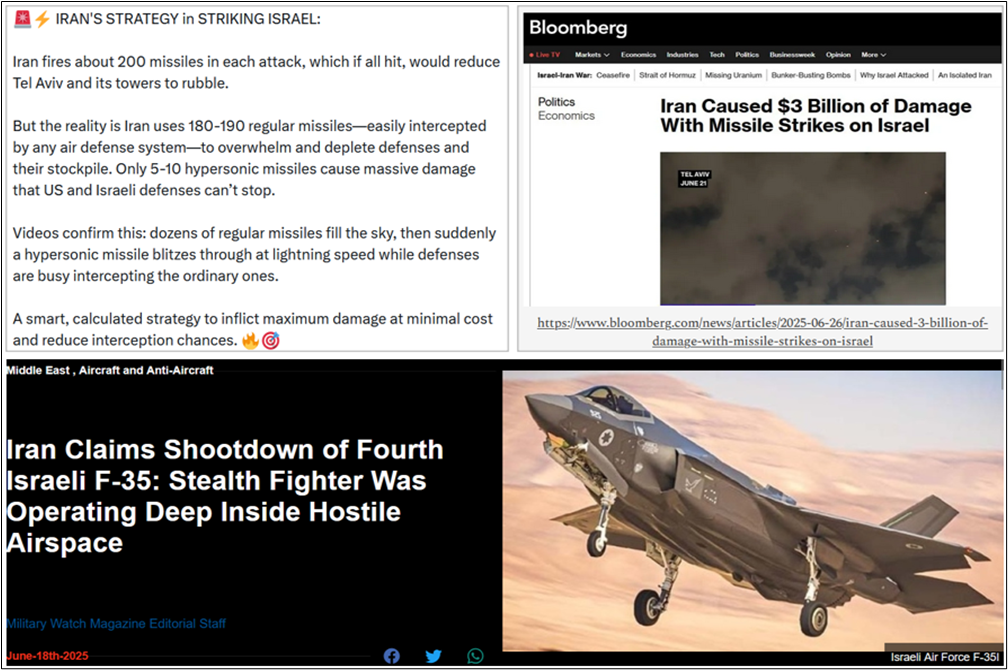
Performances of air defenses of Israel and Iran
ABM (anti-ballistic missile) defense is one of the most complex tasks for any military in the world. Adding hypersonic weapons into the mix, things become a lot more complicated, as these missiles can maneuver, rendering any calculations based on a ballistic path completely pointless. In addition to the sheer complexity of ABM defense, there’s also the matter of its exorbitant costs. For instance, it’s virtually a given that interceptors will always be far more expensive than missiles they’re supposed to shoot down.
In the beginning of Israel’s surprising attack operation, IDF managed to destroy and/or suppress Iran’s air defense (AD) systems significantly. The leaders of IRGC and Army decided to draw away and hide the rest of AD and all aircraft in underground bunkers, which turned out to be the right decision.
The 12 Day War once again exposed the ineffectiveness of US ABM systems. The THAAD (Terminal High Altitude Area Defense) is a long-range ABM system developed after the repeated failures of the overhyped US-made “Patriot” systems used during the Gulf War. In recent years, the THAAD has been deployed in the Middle East to counter Iran’s massive missile arsenal. However, the latest escalation in the long-running Israel-Iran conflict demonstrated the weaknesses of this system, particularly in terms of costs. Up to 80 interceptors were fired at incoming Iranian missiles, with mixed results, at best. The US Army has been estimated to have consumed 15-20 of all munitions for its globally deployed arsenal of THAAD systems, after deployment to support Israeli air defenses during the country’s 11 days of hostilities with Iran.
The cost of a single interceptor is up to $13 million, meaning that the US wasted over a billion dollars in munitions alone (in less than two weeks). In any sort of a prolonged war of attrition, this would’ve been simply unsustainable. Worse yet, this is without even counting the total expenditure of operating such a complex ABM system.
Despite the efforts of Israeli censors to hide the devastation Iran inflicted on Israel with its barrage of ballistic missiles, information is emerging that destroys the myth that Israel had an impregnable air defense. For the first time in its history, Israel took a major beating.
The IDF’s arsenal of Arrow anti-ballistic missiles was running increasingly thin. After just five days of hostilities with Iran, the seriousness of missile defense shortages threatens to allow Iranian ballistic missiles to strike Israeli targets with growing success. On June 17 the US and Israeli intelligence noted that “the system is already overwhelmed,” and that Israeli air defense would need to be more selective regarding prioritizing interceptions in future.
Israeli shortages of anti-ballistic missiles was already a serious issue by mid-2024, with continued ballistic missile attacks from Yemen, two large scale strikes from Iran in April and September, and to a lesser extent strikes by the Lebanese paramilitary group Hezbollah, having depleted the arsenal. Successful efforts by Hezbollah to specifically target Israeli missile defense assets reportedly worsened the situation. These shortages led the United States to play a greater role in the defense of Israeli territory from missile attacks, with the US Armed Forces as a result having also seen its arsenals of anti-ballistic missiles placed under growing strain due to the deployment of US Army THAAD and US Navy AEGIS systems to protect Israel.
Analysts have widely concluded that the IRGC has the ability to significantly escalate the scale of strikes on Israeli targets, and to begin to employ more advanced missile classes with greater success rates evading interception. The Corps on June 18 launched its first ever strike using the new Fattah ballistic missile, which is expected to be effectively impossible to intercept due to its use of a hypersonic glide vehicle.
Shootdowns of some F-35s?
Iranian government sources on June 17 reported the successful shootdown of an Israeli Air Force F-35 fighter aircraft in the skies above the city of Tabriz, with ground-based air defense systems credited with the kill. Previously two F-35s were reportedly shot down on June 13-14, with a female pilot reported captured, before a third shootdown reported on June 14 also saw the surviving pilot apprehended by commandos. However, this information has not been confirmed by independent sources.
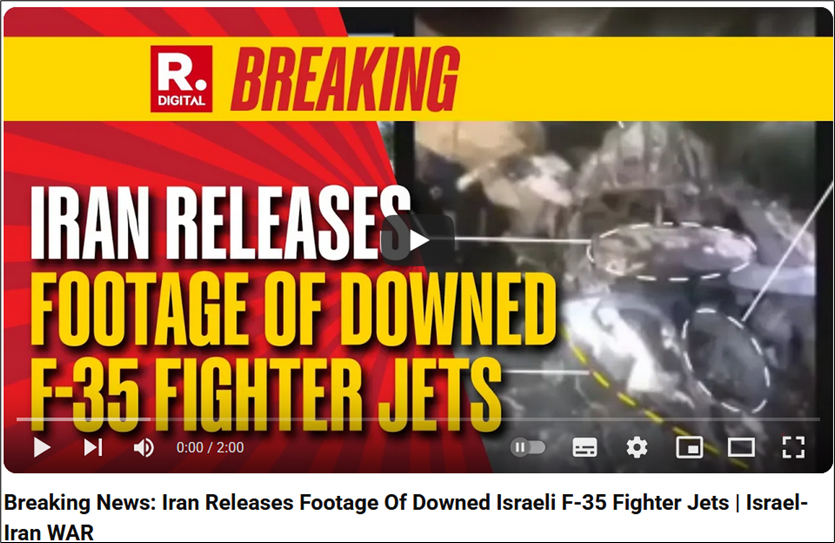
Breaking News: Iran Releases Footage Of Downed Israeli F-35 Fighter Jets | Israel-Iran WAR
Republic World , June 24, 2025
Breaking News: Iran Releases Footage Of Downed Israeli F-35 Fighter Jets Iran has released the first images of what it claims are downed U.S.-made F-35 fighter jets, describing the incident as a major blow to Western military dominance. The photos, touted as “documented evidence,” reportedly show wreckage of the advanced stealth aircraft, raising serious questions about the vulnerabilities of NATO’s most sophisticated fighter. The development is being seen as a symbolic and strategic setback for the West, particularly its European allies.
Report of Oregon State University
New information on Iranian missile attacks on Israel launched over eleven days from June 13-24 has confirmed successful strikes on key infrastructure and military facilities according to an analysis of satellite data conducted at Oregon State University. Images confirmed hits on over 40 Israeli infrastructure facilities, as well as five major military bases across the country’s northern southern and central regions.
Some of the most high-profile targets successfully hit by Iranian missiles have included Haifa Port, the Haifa Oil Refinery, Ben Gurion Airport, the Weizmann Institute of Science and Technology, Ben Gurion University, the headquarters of the defense firm Rafael, the Israel Nuclear Research Centre in Tel Aviv, and various strategic industrial sites in the city of Kiryat Gat. Military sites targeted included Israel’s equivalent to the Pentagon, the Kariya, defence ministry buildings and the headquarters of the intelligence agency Mossad, as well as Ovda Airbase and Nevatim Airbase which respectively host F-16 and F-35 fighters.
The extent of the damage to these facilities, and possible damage to others, remains highly uncertain due to the unusually strict censorship which Israel has imposed on reporting on the strikes.
Iranian strikes were launched in response to an Israeli air offensive against targets in Iran on June 13, made use of the Emad, Haj Qasem, Kheibar Shekan, or Fattah ballistic missile classes, as well as Shahed 136 and Arash 2 drones.
Commenting on the extent of the strikes at the subsequent NATO summit, President Donald Trump observed: “Especially those last couple of days, Israel was hit really hard. Those ballistic missiles, boy they took out a lot of buildings.” The attacks are estimated to have cost Israel and the United States over three billion dollars in expenditures on air defense efforts alone at a conservative estimate, with the US THAAD system alone having expended interceptors worth an estimated $810 million to $1.215 billion at a conservative estimate.
The capabilities of Iran’s ballistic arsenal are thought to be a primary factor deterring Israel and its strategic partners in the Western world from initiating a new round of hostilities, although Israeli officials have made clear their intention to launch new operations against Iran to achieve a number of objectives, one of the foremost of which is to prevent it from continuing ballistic missile production.
Winners and Losers, Political Ramifications
Washington’s view
Despite President Donald Trump’s specious claim that the US obliterated Iran’s nuclear program, Israel’s Defense Minister Katz is telling a different story:
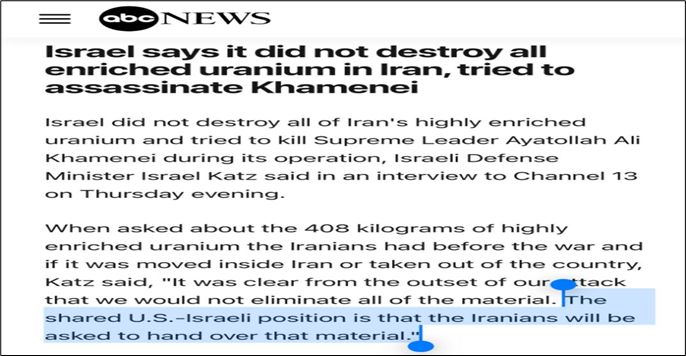
It came as Washington doubled down on its assessment that the strikes had severely undermined Iran’s nuclear ambitions. In Washington, the brawl between Trump and the intelligence community is not over.
June 25 The head of the CIA said, US strikes “severely damaged” Iran’s nuclear facilities and set them back years, diverging from a leaked intelligence report that angered President Donald Trump by downplaying the raid’s impact. John Ratcliffe, the US spy agency’s director, said key sites had been destroyed, though he stopped short of declaring that Iran’s nuclear programme had been eliminated outright.
It comes a day after a leaked preliminary assessment from a Pentagon intelligence agency suggested core components of Iran’s nuclear programme remained intact after the US bombings. Trump again maintained the raid had “obliterated” Iran’s nuclear facilities.
US Defence Secretary Pete Hegseth said intelligence gathered by the US and Israel indicated the operation “significantly damaged the nuclear programme, setting it back by years”.
This war against Iran was planned long time ago. American Retired general Wesley Clark exposed this plan in 2001 after the 911 attack on New York city. General Clark explained that he was informed of an American hegemonic war plans to take out seven countries in five years starting with Iraq, then Syria, Lebanon, Libya, Somalia, Sudan and finishing off with Iran. Iran had entered into the Joint Comprehensive Plan of Action Agreement (JCPOA) in 2015 that President Trump had withdrew from in 2018, even that the American intelligence agency, the CIA, had emphasized that Iran does not seek nuclear weapons, attacked Iran under the justification to prevent Iran from acquiring nuclear weapons.
Here below, some more views regarding Washington:
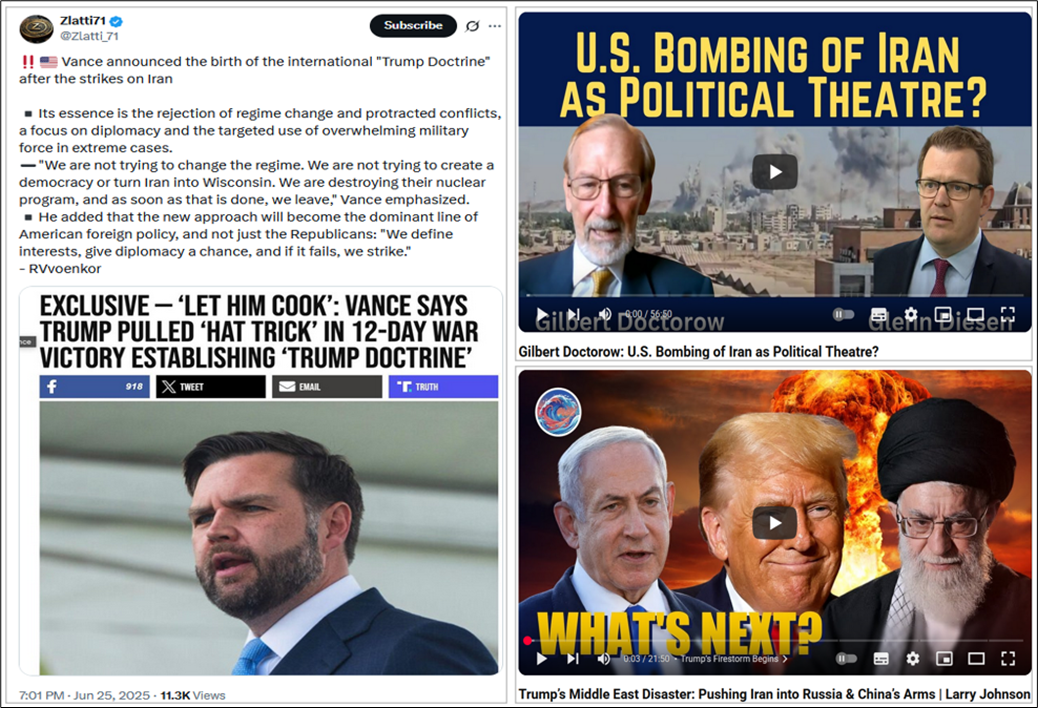
Gilbert Doctorow: U.S. Bombing of Iran as Political Theatre?
Glenn Diesen, June 23, 2025
Trump’s Middle East Disaster: Pushing Iran into Russia & China’s Arms | Larry Johnson
Counter Currents, by Larry Johnson, June 25, 2025
Former CIA analyst Larry Johnson breaks down the behind-the-scenes chaos of the Iran-Israel conflict—covert ops, cyber sabotage, and secret letters to Putin. Who really stopped the war—and who lit the match? TIMELINE: 00:00:00 Trump’s Firestorm Begins 00:01:15 Iran Strike Blueprint 00:03:01 CIA-Mossad Covert Ops 00:04:28 Iran’s Radars Blinded 00:06:59 Russia’s Offer Rejected 00:08:00 IAEA Failed Iran 00:10:07 Iran Hits Back 00:13:41 Kabuki War Games 00:15:46 Khamenei’s Secret Letter 00:17:14 Iran’s New Axis 00:20:15 Regime Change Playbook
Iran’s view
According to Ayatollah Khamenei, Iran will continue to enrich uranium. While the US and the IAEA will be calling for Iran to give it up, Iran will go on ahead. Iran does not trust any deal offered by Trump in light of his betrayal of the previous negotiations and the same with the IAEA. Iran has denied any co-operation with it.
Iran will solidify the military ties to Russia and China (and North Korea), launch a massive counterintelligence campaign to identify and eliminate those elements collaborating with Mossad and Western intelligence agencies, replenish and harden air-defense systems, and build more ballistic missiles.
One obvious danger from the perspective of Western decision-makers (and Israel): if Iran was not intent on getting a bomb before, they likely are now – given their very existence is under threat. It is especially the Iranian hardliners which will understand the ‘two paths’ and existential question facing Iran:
1) Become a failed state like Libya after ‘giving up’ nuclear or WMD potential (precisely as Gaddafi did when offered ‘incentives’ by Bush/Cheney/Rice).
2) Or, become North Korea and you are immune from regime change wars launched by the West.
For the Iranians, the question of negotiations with the US at this point means negotiating their own demise – given they have already been relentlessly bombed. While the US may not be openly calling for regime change in Tehran, the reality is that many within Israel’s top leadership, including Netanyahu, have.
Tehran certainly knows this, and has likely already chosen path 2 – at a moment Israeli leadership is probably worried about a future nuclear dirty bomb going off in Tel Aviv. In many ways, Trump’s brazen bombing operation, took things from bad to worse. We could for now with this Trump-backed ceasefire just be witnessing a ‘pause’ before a much worse storm on the horizon, whether that happens days, weeks, or months from now.
Iran’s supreme leader has insisted the US “gained no achievements” from strikes on its nuclear facilities, in his first public address since a ceasefire with Israel was agreed on Tuesday. Ayatollah Ali Khamenei said the strikes did not “accomplish anything significant” to disrupt Iran’s nuclear programme, and described the retaliation against an American air base in Qatar as dealing a “heavy blow”.
Iranian nuclear power allies – Pakistan, Russia, China, and North Korea – are highly likely to join in the conflict, if needed, not just to protect Iran but also to protect themselves since they know very well that they could be the next American Israeli targets.
This American attack will not scare Iran to its knees, rather it will convince them that obtaining nuclear weapons, like other nuclear countries, will be an effective deterrent and protective weapon they should have. They would withdraw from the Non-Proliferation of Nuclear Weapons Treaty (NPT) and rush into developing their own deterrent nuclear weapons.
The potential blocking of the Strait of Hormuz by Iran will not spare the US, triggering a “global oil shock”, because oil is priced globally. If the Strait of Hormuz is shut, the US won’t be spared. No one is immune from a global oil shock – prices at the pump will skyrocket.
US & Israel’s long planned attack to regime change Iran did fail. Control by the military and political leadership of Iran was never in doubt. Attempts to kill Ayatollah Khamenei were unsuccessful. The military response to the Israeli attack was quick and successful. After just twelve days of war Israel sued for peace. Iran agreed but may well rue that decision in future. Iran had the advantage of being able to fight and win an attritional war against Israel.
A secondary objective of Israel and the US was to eliminate its nuclear program. That part also failed. Several strikes have damaged Iran’s primary enrichment facilities. But it has retained the highly enriched Uranium. It also retained a sufficient number of its most modern centrifuges and so far, unused underground facilities to further enrich it to weapon’s grade. Should Iran decide to make nuclear weapons it could have them within a few months. Iran has ended all cooperation with the IAEA. The eyes and ears of western intelligence on the ground in Iran are no longer there. Future strikes will thus lack precision.
Moscow’s view
Russia’s stance versus Israel and Iran is very interesting, comprehensive, multifaceted and ambivalent.
For Moscow, Iran is not just a partner – it’s a pillar in the buffer zone securing Russia’s southern flank. Instability in Tehran could ripple across Central Asia, threatening Russia’s near-abroad. In January of this year, Russia and Iran signed a comprehensive strategic partnership agreement, institutionalizing bilateral ties and hinting at a future formal alliance.
Tellingly, just days after Israeli airstrikes targeted Tehran, Iranian Foreign Minister Abbas Araghchi flew to Moscow, met with President Vladimir Putin, and held talks with Lavrov. He later described the visit as marked by “complete mutual understanding” and emphasized Russia’s support in an interview.
Russia, along with China and Pakistan, has since pushed a new UN Security Council resolution calling for an immediate ceasefire and a pathway to political settlement. As Russian envoy Vassily Nebenzia noted, the resolution aims to stop further escalation.
Yet Moscow has been careful in its public rhetoric. At the St. Petersburg International Economic Forum, Putin avoided inflammatory language toward Israel, instead stressing the need for a diplomatic solution acceptable to all sides. This cautious tone reflects Russia’s balancing act: deepening ties with Tehran while maintaining working – and in some cases warm – relations with Israel, including in military and humanitarian channels. That dual posture allows Russia to position itself as a potential mediator, should either party seek a negotiated outcome.
On June 13, as Israeli airstrikes intensified, Russia quickly condemned the attacks and voiced strong concern about violations of Iranian sovereignty. Putin went further, calling US behavior in the region “unprovoked aggression.” Moscow’s message was clear: it opposed outside military interventions – full stop. Days before Araghchi’s trip, Putin publicly revealed that Russia had offered Iran expanded cooperation on air defense systems, an offer Tehran had not pursued. Far from a rebuke, it read as a nudge: if the strategic partnership is real, Iran needs to meet Russia halfway.
Crucially, the 2025 strategic agreement between Moscow and Tehran does not entail mutual defense obligations. It is not the Russian equivalent of NATO’s Article 5, nor does it mandate automatic military assistance. As Putin clarified, the pact reflects political trust and coordination – not a blank check for joint warfare.
In fact, the treaty explicitly forbids either side from supporting a third party that launches aggression against the other. The architecture of the partnership is built on sovereign respect and strategic equilibrium – not entangling commitments. It centers on military-technical cooperation, coordinated diplomacy via BRICS and the SCO, and shared interest in regional stability. But it stops short of dragging Russia into wars that don’t pose a direct threat to its national security.
One development drew particular attention: just after Araghchi’s Kremlin visit, US President Donald Trump abruptly called for a ceasefire and adopted a noticeably softer tone on Iran. Whether by coincidence or not, the shift in US rhetoric suggests Moscow’s influence may have quietly shaped the trajectory of events. Russia, after all, is one of the few actors with open channels to both Tehran and Tel Aviv. It’s entirely plausible that the Kremlin served as a behind-the-scenes intermediary, securing at least a temporary pause in hostilities.
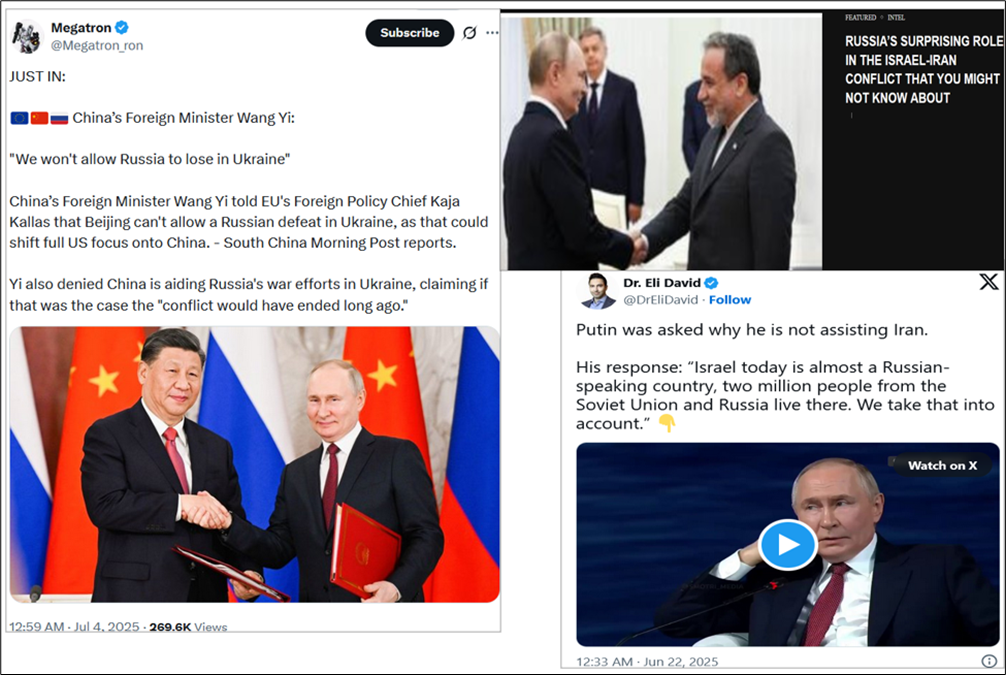
Well-known commander of the Akhmat special forces of the Russian Army, Lieutenant General Apti Alaudinov said that “US President Donald Trump has saved Israel from complete defeat in the war with Iran”. Many in Russia share his opinion.
Beijing’s view
China has chosen their side and they will stand with Iran.
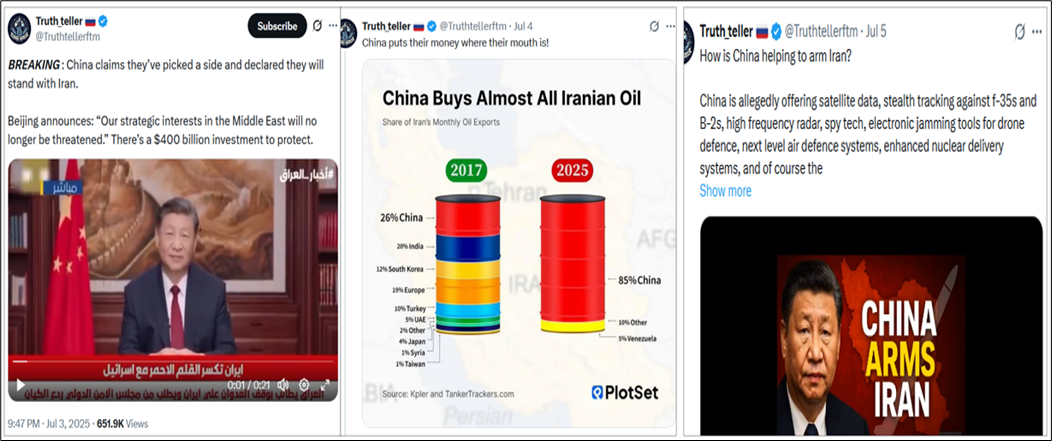
Military and other aid and support are massive, concrete and tangible.
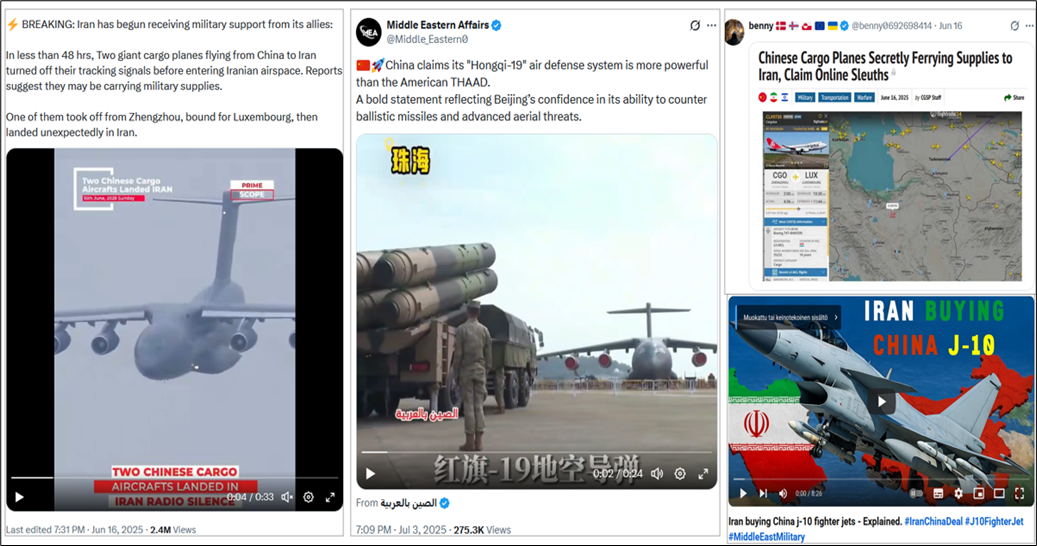
Iran buying China j-10 fighter jets – Explained. #IranChinaDeal #J10FighterJet #MiddleEastMilitary
SHKamran, June 29, 2025
Iran is reportedly negotiating with China to purchase advanced J-10C fighter jets. These fourth-plus generation aircraft could mark a major leap for Iran’s aging air force. Talks include price, delivery, and limited tech transfer. The J-10C features an AESA radar, WS-10B engine, and long-range PL-15E missiles. Its delta-canard design allows takeoff from high-altitude bases, making it ideal for Iran’s mountainous terrain. Strategically, the deal shifts regional dynamics. With PL-15E missiles, Iran could challenge air superiority in the Persian Gulf, prompting responses from Saudi Arabia, UAE, and Israel. While not finalized, the potential deal strengthens Tehran-Beijing ties. It also reduces Iran’s reliance on Russia, introduces new air capabilities, and complicates U.S. regional strategies.
Some closing remarks
Before the US and Israeli strikes on its nuclear facilities Iran was a long-standing member of the Treaty for the Non-Proliferation of Nuclear Weapons (NPT). The IAEA, tasked with verifying the adherence to the NPT, was able to inspect Iranian facilities. It knew, how much enriched Uranian Iran had produced and where it was stored. The NPT’s objective was to prevent the spread of nuclear weapons and weapons technology and to promote cooperation in the peaceful uses of nuclear energy. The second part was the reason why non-nuclear nations have joined the treaty. All that is now in doubt.
There are serious concerns that the IAEA has leaked the names of Iranian nuclear scientists to Israel which in the end led to their assassinations. From Iran’s side a continuation of its membership in the NPT and any cooperation with the IAEA have lost their purpose. There is no longer any reason to stay within the agreement. Iran is likely to leave the NPT.
A senior Iranian source claimed to Reuters that before the US attack on the Fordow nuclear facility, all of the stock of enriched uranium at the site was transferred to another location. At the same time, satellite images captured a large convoy moving near the underground nuclear facility two days before the attack. It is believed that this may be documentation of the transfer of the enriched material.
Some 400 kilogram of Uranium, enriched to 60% of U-235 isotopes needed for fission chain reactions, were squirreled away. The IAEA does not know where they are. Iran also still has a sufficient number of its most modern centrifuges needed for further enrichment
The attacks on Iran’s nuclear facilities were not done to prevent it from getting nuclear weapons. The attacks are to provoke a violent response which can then be used to launch an all-out war with the end-purpose of regime change in Iran.
There is however no easy way to regime change Iran. The Iranian society is largely standing behind its government. That government is well established and seen as legitimate. It does not depend on one person. Even the Supreme Leader Ayatollah Ali Khamenei is easily replaceable. The regular military is counterbalanced with the Iranian Revolutionary Guard Corps. This makes a military coup plot untenable.
The Israeli government launched its attacks on Iran under the operation name ‘Rising Lion’.

The flag on the left is the flag of the Islamic Republic of Iran. The flag on the right, depicting a lion in front of the rising sun, is the flag of Iran under the former dictatorship of the Shah. The US and Israel are currently promoting the son of the deposed Shah of Iran as the future leader of the country. ‘Rising Lion’ was and is thus an obvious reference to a regime change operation in Iran.
Unless there is a large-scale foreign land invasion, supported by this or that minority in Iran, there is no chance to topple the Islamic Republic. The US no longer has the Cold-War army that would potentially be able to do such.
Israel depends on air defenses manufactured and provided by the US. Their production is limited and it depends on the availability of rare materials. China is currently withholding rare earth licenses from US weapon producers. This will further decrease the availability of air defense items.
Israel knows that it cannot sustain an attritional war with Iran. This is a similar situation as Ukraine faces in the attritional war with Russia. These two current crises have revealed a hard and cold reality in the today’s world:
the East Camp (China, Russia, Iran, North Korea) is superior over the West Camp (the US, Europe, NATO) in the modern warfare with attritional features.


